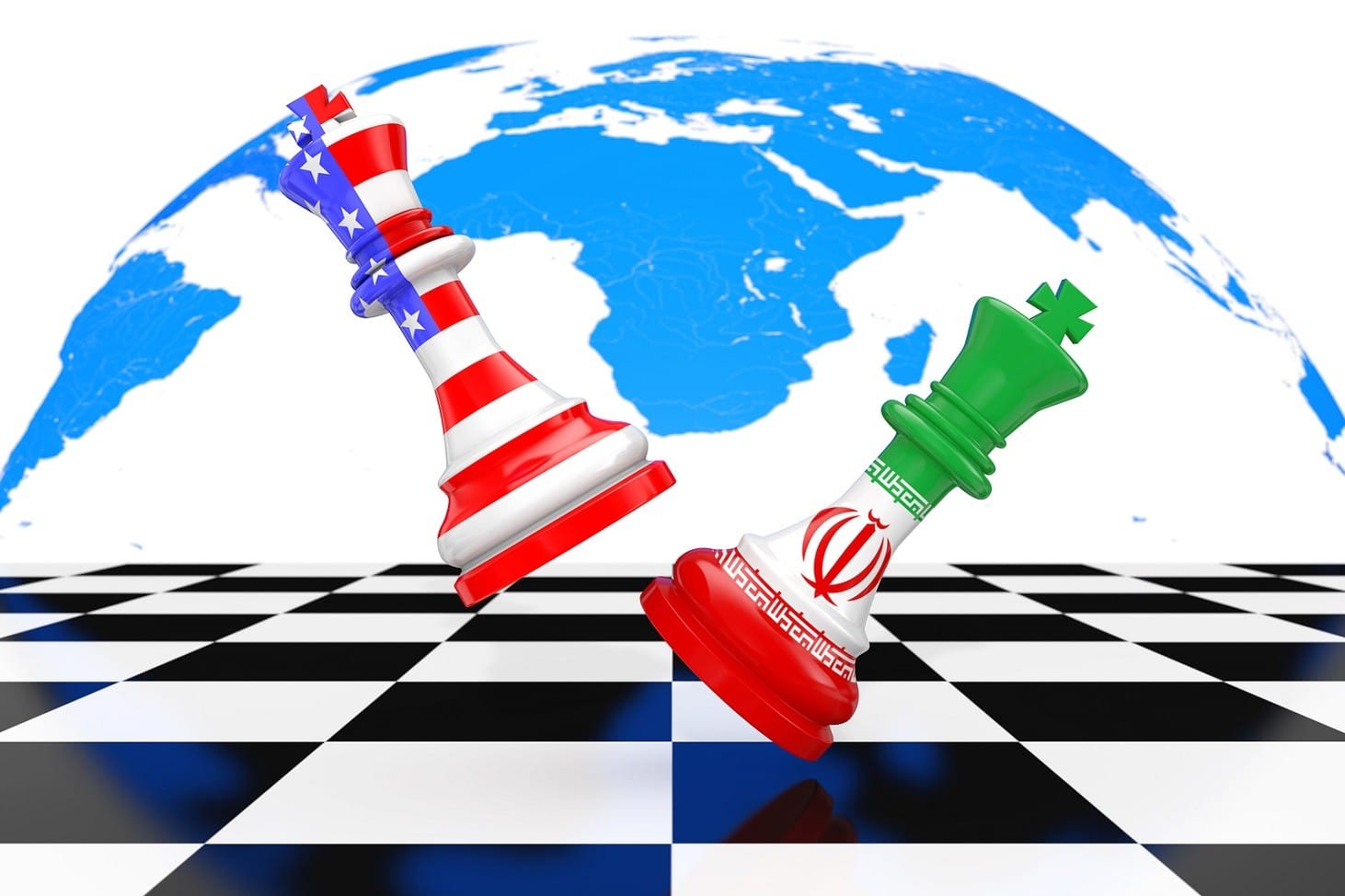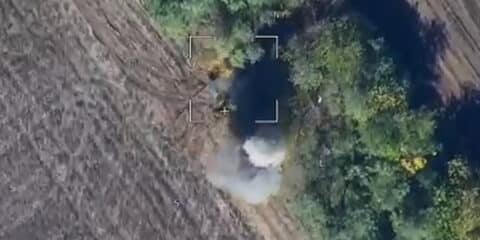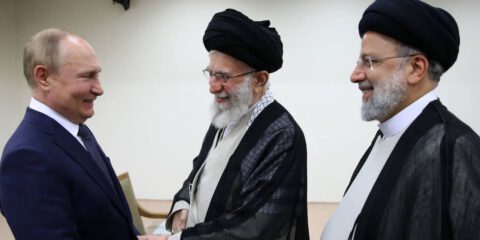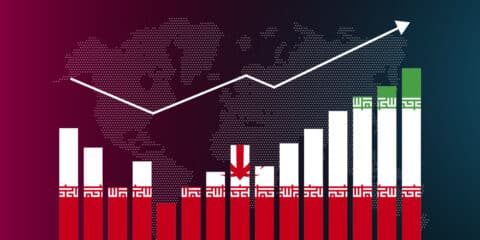Most of the regional players are wary an escalation between the US and Iran, a conflict which would be conducted across the Middle East and will have wide implications. If Iranian miscalculation leads President Trump to commit to a significant campaign against Tehran, countries wary of Iranian influence could change their posture, and become more explicitly in line with American positions and interests.
From the Shiite holy cities in Iraq to Tehran, and finally Qassem Soleimani’s hometown Kerman, millions of mourners came out last week to pay respects to the slain Iranian general. It was the biggest funeral in Iran since that of Ruhollah Khomeini in 1989. As red Shiite battle flags fluttered above masses of weeping mourners, no observer could doubt the singular place Soleimani occupied in the hearts of the Iranian regime and its supporters.
They have good reason to mourn Soleimani’s death at American hands. The Iranian Revolutionary Guards Corps – Quds Force commander was the figure driving the expanse of Iranian power throughout the Middle East through proxies, terror, and soft power. His killing on January 3 by an American Reaper drone was a major blow for the Islamic Republic, and will profoundly influence Iran’s actions moving forward. What exactly that influence will be is the question that academic experts and intelligence analysts will be working to answer in the coming months. Will the IRGC be able to carry Soleimani’s vision forward with the same operational proficiency and commitment, or will it become clear that he was the foundation upon which Iranian designs rested?
The other central question is how the strike will influence the other actors in the Middle East, both those who support Iran’s ambitions in the region and those who have coalesced into an alliance against it. This study examines the interests and potential reactions of the players located in the ‘first ring’ of the recent escalation between the US and Iran – those within Iraq itself and on its border. These players are forced to react to this surprise as they attempt to interpret Iran’s reaction, Trump’s policies in the region, and the great power competition between US and Russia in the Middle East.
Iraq – Managing the Tensions
A week after Soleimani’s death, Iraqi Prime Minister Adel Abdul Mahdi asked US Secretary of State Mike Pompeo to initiate procedures that would lead to the complete withdrawal of American forces in Iraq. This request came after the Iraqi Parliament called for the exit of US forces from the country.[1]
Although the White House won’t automatically rule out the tempting notion of bringing American troops home during an election year, the operational and strategic ramifications of a withdrawal are not so simple. The ability to complete the long mission of stabilizing Iraq from insurgency, support the American and Coalition forces in Jordan and Syria and continue an effective campaign against the Islamic State, depends on maintaining the military bases in Iraq and air and intelligence supremacy.
Furthermore, in order to support its key allies Jordan, Saudi and Israel against Iranian activity, the US needs to keep boots on the ground in strategic locations like the Al-Tanf base near the Iraq-Jordan-Syria border, counteract Iranian entrenchment along the Iraq-Syria border, and prevent growing Iranian influence in Iraq.
The Iraqi call for US withdrawal is not as drastic as it may seem. Although the public and the political outrage is real, the Iraqi government understands the severe strategic implications of an American decision to cut its military and economic backing in the framework of a forced withdrawal.[2] The hard-gained fragile stability gained and the fear of potential chaos emphasize the necessity of a rational strategy that maintains American support.
But in Iraq, this is especially complex. The flames of immediate emotional reactions are fanned by wounded honor and the ideological stubbornness that sometimes replaces strategic decision-making in the region. Authentic rage against US actions can obscure long-term interests.
In any event, the Iraqi government understands that US withdrawals are not immediately implemented, as the anticipated withdrawal from Syria showed. From the Iraqi perspective, a slow, careful withdrawal is not such a bad outcome.
However, if Iraq becomes a battleground for extensive military clashes between the Shi’ite militias and the US military, it could intensify Iraqi government demands for a rapid US withdrawal. Similarly, if the US and/or Israeli military continue to allegedly target arms transfers, infrastructure and Shi’ite militia entrenchment in the Iraq-Syria border, it would heighten existing tensions, as well as the public and political pressure on the government.
Iraqi Kurdistan – Still Waiting for America
The Kurds of northern Iraq have been disappointed by the United States in recent years. The Trump Administration came out publicly against the ultimately disastrous 2017 Kurdish independence referendum, and in the eyes of many Kurds, stood by the wayside as Iraq, Iran, and Turkey punished the Kurds, closing down its airports and taking Kirkuk and its oilfields by force. The US withdrawal from positions in Syria in advance of the Turkish incursion in 2019 further cemented the sense of betrayal. Still, the KRG’s ultimate goal remains an independent Kurdistan with firm US backing and security guarantees.
As long as the Trump Administration is seen as uninterested in reinvesting in bilateral ties with regional allies, the Kurds have no choice but to balance their distant ally, the US, with their close frenemy, Iran.
There are reasons for Iranian-Kurdish cooperation beyond a temporary alignment of interests. Persians and Kurds share deep cultural, historical, and linguistic ties, and Iranians don’t have the animus toward Kurds that Arabs and Turks often display. It was Iran that provided immediate aid to the survivors of the 1988 Halabja chemical attack by Saddam Hussein’s forces. Iran has deepened ties with the Patriotic Union of Kurdistan Party, and has made inroads into the PUK-breakaway Gorran party. Bilateral trade, worth only $100 million annually in the year 2000, has surpassed $6.5 billion two decades later.
Even with these existing ties, Soleimani was the hub around which the Iran-KRG relationship revolved. With the 2014 ISIS invasion and the lackluster performance of the peshmerga forces, Soleimani took action. Unverified Kurdish reports claim Soleimani arrived at the head of a 70-vehicle military convoy the night of the IS invasion. A few months later, Iranian television aired images of Soleimani with peshmerga fighters on a battlefield, reported to be Jurf al-Sakhr south of Baghdad. “Iran protects Erbil and Baghdad the same as it protects Iranian Kurdistan,” said Iranian President Hassan Rouhani in 2015. Iran was the peshmerga’s main arms provider, especially BM-14 and BM-21 truck-mounted rocket launchers.
Soleimani knew how to finesse the Kurdish political system. He knew whose hands to shake, who to pay, and of course, who to threaten. The smiles and photo opportunities all took place under the threat of Iranian force. After all, it was Soleimani who engineered the Iraqi capture of Kurdish controlled Kirkuk, rich in oil as it is in national symbolism for Kurds. “After the nosebleed Soleimani handed Barzani a handkerchief,” remarked Iraq scholar Bilal Wahab of the Washington Institute for Near East Policy.
Tehran has been underwhelmed by the KRG reaction to the Soleimani killing, to say the least. No members of the powerful Barzani family – who include the KRG president and prime minister – signed the condolence book at the Iranian consulate. “We expected more on this terrorist act,” lamented Iran’s consul general. “We expected a clearer and louder denunciation of what happened.”[3]
Iran has made sure to remind the Kurds that they’d be well served to stay in line. It was no coincidence that in response to the killing of Soleimani, Iran struck Erbil International Airport, an international civilian airport where US troops are also based. In the Iraqi parliament vote demanding that the federal government take steps to end the presence of foreign troops in Iraq – a clear rebuke to the US – all Kurdish lawmakers boycotted the session, and even convinced some Sunni parliamentarians to do the same.
While the Kurds clearly desire a permanent US troop presence in Iraq, they are in no position to be openly pro-American. But there is potential for them to be firmer in the face of Iranian pressure. The Hellfire missiles that destroyed Soleimani’s convoy also left Iran’s aura of invincibility badly damaged. In December, pro-Iranian elements of the PUK were elected to key positions in the party. After the strike, sources close to the PUK say if the party convention took place now, the results would be look very different. Kurdish officials who dealt with Soleimani over the past two decades have indicated that they do not know of anyone in the Iranian regime who can replace him, nor is there anyone else they would accommodate in the same way, according to Kurdish journalist Rebaz Ali. [4]
The Kurdish appetite for rolling the dice like they did in 2017 remains low. Soleimani’s disappearance from the scene won’t change that. The Kurds will still need to balance Iran’s proximity with their long-term desire for a firm alliance with the United States. But the balance has shifted, and the full extent of that shift depends on America’s strategic posture in the Middle East, and in Iraq, moving forward.
Syria – New Opportunities
Syria and Iran are strategic allies, often described as the axis of resistance to American and Israel dominance of the region. The strategic and operational ties go back to the 1980s, and Iranian presence and aid to Syria is not a new phenomenon. However, the eruption of the Syrian civil war increased dramatically the level of military support Iran and its proxy Lebanese Hezbollah provided to the Assad regime.
The Syrian civil war enabled Iran to project its influence in building a military axis from Tehran, through Iraq and Syria to Lebanon. The vision of an “Iranian crescent” that will deter Israel from more than one front and transform Iran to a regional economic and military power has begun to manifest itself in the Syrian arena.
The Syrian regime fought for its survival in the bloody civil war with the aid of the Russians, Lebanese Hizballah and the IRGC. The extensive support Iran provided the Syrian regime came with a price tag – Iranian entrenchment in Syria as a part of the plan to establish advanced military capabilities and infrastructure to deter and counter Israel and American military power in the region. It is also designed to create flexibility in the use of power against Israel, in order to keep Hizballah as a strategic asset for the “big war” when it arrives.
Soleimani’s demise offered a new opportunity for President Assad to leverage the strategic partnership with Iran in his favor.
Soleimani was busy since the civil war in Syria began. The “Other Revolution in Military Affairs” that Soleimani crafted in the Middle East aimed to diminish the technological military advantage of Israel and the US by developing and obtaining massive accurate fire power; establishing logistical and operational infrastructure in Iraq and Syria; and funding, training and operating proxies that are nimble enough to stay below the threshold of war in Yemen, Iraq and Syria.[5]
The problem was that with the realization of Soleimani’s plan came a reaction, and Syria became a battleground between Israel and the IRGC. Syria was drawn into the fight, sometimes against its will and strategic interests.
The loss of Soleimani’s strategic leadership enables the Syrian regime, with Russian guidance, to reevaluate the nature of the partnership with Iran. It will likely seek to stress the need for operational coordination while looking to reduce Iranian influence and military entrenchment in Syria.
The strategic aim of the Syrian regime is to win the civil war and consolidate its power and sovereignty all over Syria territory, to be accepted as a legitimate country in the regional and international arena and to start with the long-awaited reconstruction and rehabilitation projects. Continuous military friction with Israel as the result of IRGC entrenchment doesn’t correlate with the strategic big picture.
The killing of Soleimani creates a window of opportunities for the Syrian regime to redefine the strategic and operational partnership between Iran and Syria. Changing the nature of operational and military coordination with Iran could reduce the danger of major escalation with Israel, which would likely be fought largely on Syrian territory, jeopardizing Assad’s stability and the reconstruction efforts.
Turkey – A gift at a Challenging Time
Turkey’s view of Iran is marked by a dichotomy. In some ways Turkey shares mutual interests with Iran, especially in the effort to limit Saudi and GCC influence. Iran is a major trading partner for Turkey, though levels have been down this year. Both countries are also eager to prevent any moves toward Kurdish independence in Iraq or Syria.
On the other hand, Turkey is a Sunni power, and was a primary backer of anti-Assad rebel groups in the Syrian civil war. Ankara has no desire to see a Shi’a dominated arc from Iran to Lebanon on its southern flank. The death of Soleimani, seen as a dangerous figure in Turkey, significantly damaged the IRGC-QF’s ability to cement Iranian influence across the Middle East, much to Turkey’s relief.
The Soleimani strike comes as Turkey is trying to balance between Russia and the US, with only partial success.
Turkey’s relationship with the US is complex, and there have been recent tensions. There is a long-standing paranoia among Erdogan and his supporters about American designs to overthrow the regime. Senior Turkish officials and pro-government newspapers pointed their fingers at America for masterminding the failed 2016 military coup. Ankara demanded the US extradite exiled Turkish intellectual Fethullah Gulen for his alleged role in the plot, which America has refused to do. Turkey and the US were unable to come to terms for the purchase of Patriot anti-ballistic missile system, and Turkey’s decision to buy the Russian S-400 anti-aircraft missile system forced them out of the F-35 project. In addition, the Trump Administration is still legally bound to sanction Turkey for the S-400 purchase. Ankara is working closely with Russia elsewhere, including on ceasefires in Idlib and in Libya despite supporting opposite sides, and the newly opened Turkstream gas pipeline.
Still, Turkey is not about to end its strategic alliance with the US. Turkey understands US economic and military might is far beyond that of Russia, and has invested significant effort in explaining its views and reaching agreements. Trump and Erdogan have found some personal rapport, which paid off for Turkey in easing the way for their recent campaign in northern Syria against Kurdish forces.
Turkey’s major concern in the wake of the strike is to preserve calm and stability. It borders Iran, Iraq, and Syria, and doesn’t want US forces in the country to become the target of an Iranian response. Erdogan is not looking for conflict with Trump, and restored calm allows Turkey to remain out of the fray in the US-Iran fight while enjoying potential benefits of a weakened IRGC. Turkey is deeply involved in the Libyan civil war as part of its effort to bypass the Egyptian-Israeli-Greek-Cypriot gas project, and wants to keep America from interfering with its efforts there.
Turkey’s response to the killing reflected its desire to avoid escalation and not to appear too sympathetic to either side. In the two days after the attack, Erdogan released no statement, and official Turkish releases were tepid calls for calm. “It should be known that these escalating steps, which threaten the stability of our region, will increase the spiral of violence and that all sides will be harmed by this situation. Turkey has always been against external interventions, assassinations, and sectarian efforts in the region. For this reason, we are inviting all sides to act with common sense and restraint, to avoid unilateral steps that will endanger the peace and stability of our region, and to give priority to diplomacy,” read the Foreign Ministry’s statement, which neither supported nor condemned the attack. In the meantime, Turkish pro – government media vilified Soleimani.[6] When Erdogan finally spoke, he emphasized that he was not informed of the operation ahead of time and the importance of de-escalation. Furthermore, Turkey sent no officials to Soleimani’s funeral.
Turkey will likely seek to avoid antagonizing either side in the fallout from the attack, and instead play to maximize the benefits the strike offers for a country facing multiple diplomatic challenges. It will seek to take advantage of Soleimani’s death to strengthen its position in Syria at the expense of the pro-Iran bloc. If the US continues to maintain a deterrent posture, or intensifies its operations over Iraq, US airbases in Turkey will become even more important, giving Turkey additional leverage. They will become even more critical if the US draws down troop level even further in the wake of Iraqi outrage at the killing. If there is a significant reduction in fear and respect for the IRGC, the Kurds in Iraq will be forced to strengthen their relationship with Turkey, giving Ankara increased leverage in the Kurdistan Region and in Iraq in general. [7]
As with other regional actors, much depends on US policy and the state of tensions between Tehran and Washington. If Turkey sees that the US is recommitting to the use of force in the Middle East, it may see reason to moderate its anti-American rhetoric, and seek to change course somewhat on its orientation toward Russia. But Turkey will likely continue to struggle to navigate between Russia and the US, and prioritize gaining leeway against the Kurds and in Libya while not antagonizing Trump unnecessarily.
Saudi Arabia – Seeking Calm, For Now
The Saudis have long been bitter rivals of the Iranian regime. The enmity is rooted in the 1400-year-old struggle between Sunni and Shi’ite Islam. The Sunni House of Saud, with its stewardship of Mecca and Medina, regards itself as the leader of the Muslim world, a position challenged by the Shi’a theocracy of the Islamic Republic since the 1979 revolution. Both countries have worked through aligned states and armed proxies to enhance their influence and prestige, and in recent years, Iran has shown itself far more skilled at this form of competition.
Tensions between the countries increased in the wake of Saddam Hussein’s 2003 ouster in Iraq, which led to Iranian domination of Saudi Arabia’s northeastern neighbor. Revelations around Iran’s nuclear program, Iranian support for Bashar Assad in the Syrian Civil War, and a bizarre Iranian plot to assassinate the Saudi ambassador to the United States significantly dented the relationship since then. But it was the 2016 execution of Saudi Shiite cleric Nimr al-Nimr that set off a series of events resulting in Riyadh expelling Iranian diplomats from the kingdom and cutting diplomatic and commercial ties. The two countries have yet to restore relations.
To the south, Saudi intervention in support of Yemeni President Abdrabbuh Mansur Hadi against Iran-backed Shiite Houthi rebels led to a costly military stalemate for Riyadh. The Saudis now seek to lead a political reconciliation process and have scaled back their military efforts.
President Trump has made a point of strengthening the US-Saudi relationship. But the Saudis have been disillusioned by the lack of an American military response to the June 2019 downing of a US drone by Iran and the September 2019 drone attacks on Saudi Aramco oil processing facilities. The loss of faith in the reliability of American willingness to exercise military force, has led the kingdom to seek instead to re-open dialogue with Iran. Multiple media reports indicated the Saudi were exploring opening diplomatic discussions with Iran through Iraqi and Pakistani mediation. It should be noted that the Saudis and Iranians have tried many times to reach rapprochements in the past, with limited success.
In the wake of the Soleimani strike, the Saudis understand that they offer a ripe target for Iranian retaliation. They have shown themselves incapable of securing strategic facilities, and can’t strike back at key Iranian interests in the way Israel has proven it can. In addition, Riyadh is eager to protect the political process in Yemen and avoid returning to the military quagmire there. Though Middle East investment have proven resilient in the face of recent attacks, the Soleimani strike and the Iranian response drove Aramco shares down to their lowest level since its market debut in December. Further instability would cost the oil giant billions in market value, and the kingdom would find it difficult to attract the investment it needs to transform the economy in line with Crown Prince Mohammed bin Salman’s Vision 2030 program.
Saudi Arabia views its significant indigenous Shiite population as a potential fifth column. The House of Saud has long sought to curry favor with Wahhabi religious leaders through their persecution of Shia, and pervasive anti –Shiism is built in to Saudi religious, cultural and social institutions.[8] Though Saudi Shia usually strive toward political quietism, Iran has sought to fan the flames of discontent through support of Saudi Shi’a groups. Tehran succeeded in organizing hardline Shi’a clerics into Saudi Hezbollah, which attacked oil facilities, assassinated Saudi officials, and bombed the Khobar Towers complex in 1996, killing 19 American military personnel. Though Saudi Hezbollah largely disappeared in the aftermath of the attack, many believe that the IRGC maintains Saudi Hezbollah sleeper cells. US intelligence officials alleged that Hezbollah members acting under Iran’s direction were behind a major cyber-attack on Aramco in 2012. [9] These cells could be activated by Iran to strike back against American allies.
Not surprisingly, the Saudi were quick to stress publicly that they were not consulted on the Soleimani strike. Senior officials publicly emphasized the importance of de-escalation and made the same case to their American counterparts.
Of course, if the Trump Administration displays a commitment to confront Iran with force in the region, it is conceivable that the Saudi give up their attempts at political solutions and return to a more aggressive posture against their Shiite rivals. But for the time being, the kingdom is looking for stability and de-escalation.
Jordan – Stability and Border Security
Relations between Jordan and Iran became strained after the Islamic Revolution in February 1979 and the ouster of Mohammad Reza Shah. Jordan then backed Saddam Hussein in the Iran-Iraq War (1980- 1988), which led to the severing of diplomatic ties with Iran. Relations did improve in the early 1990s, but they deteriorated again after Jordan signed the peace treaty with Israel in 1994.
The animosity between the countries is rooted in divergent ideological, religious and political views. The core differences lie with Iranian support for Hamas, while Jordan supports the official Palestinian National Authority and the PLO; the insurgency activity that Iran sponsored on Jordanian soil starting in the 1980s; the close relations between Jordan and the Sunni camp (especially with Saudi Arabia); Jordan’s cooperation with the US and its military presence in Jordan; and opposing positions on the Syrian issue and especially the faith of the Assad regime and the preferable future political process.
The war in Syria represented an opportunity for Iran to project its influence in the region, and Tehran took advantage. The expansion of Iranian influence in the region through Soleimani’s endeavors was felt all throughout the Middle East, and Amman viewed it as a national security threat. The Syrian civil war also intensified border security threats for Jordan, especially those derived from the activity and entrenchment of pro-Iranian militias.
Amman saw the crisis between the US and Iran that reignited after the withdrawal of Washington from the Joint Comprehensive Plan of Action (JCPOA) in May 2018, as an opportunity to diminish Iran’s regional activity and influence. It might also divert Iranian attention from Jordan. On the other hand, the possibility of deterioration to regional war between the US and Iran had the potential to threaten Jordan’s stability and security.
The situation only got more complicated with the killing of Soleimani. Jordan is concerned that a spillover from Iraq could jeopardize the current fragile stability. Jordan has a significant American presence – civilian and military – that could be a potential target for Iranian IRGC revenge. US embassy staff in Baghdad were evacuated to Jordan after the Soleimani strike, and other military assets were also transferred to the kingdom. Amman is wary of suffering collateral civilian damage from such an attack. The growing possibility of retaliation against US targets in Jordan, from Iraq, Syria or Lebanon, requires Amman to strengthen its border protection and tighten military cooperation with the US and Israel in order to counter terrorist infiltrations.[10]
Strategically, the elimination of Soleimani could affect the operational proficiency of the Shi’ite militias in Syria and Iraq, thus reducing the long-term threat to Jordan’s border. Furthermore, it could diminish the regional influence of Iran. On the other hand, a scenario where the US withdraws from Jordan and Iraq, while Iran continues with the same regional strategy and efficiency, would force Jordan to reach for a pragmatic solution in order to solve its border protection threat, the refugees issue, and to strengthen its ability to counter Iranian proxy insurgencies in Jordan.
Historically the tensions between Jordan and Iran were manageable, but recent Iranian expansionist ambitions and activity in Syria and Iraq undermined Jordanian core interests, increased the tension and the fear of an eruption that will jeopardize Jordan security and stability.[11]
Jordan would prefer a weakened Iran with a US deterrent regional presence that reduces the multi-dimensional threat posed by Tehran. The coming weeks are crucial in Jordan’s perspective for the shaping of the regional architecture after the killing of one of the most important players.
Looking Forward
Four camps are fighting for dominance of the contemporary Middle East: The Shi’ites, the Sunnis, the political Islam camp and the Salafi-Jihadists. In addition to these groups of Muslim actors, one must also consider Israel, a regional military and economic power. Israel is determined to block Iran’s vision of an ominous “Iranian axis” armed with accurate fire power that aims to deter Israel and limit its freedom of action. Furthermore, the shared Iranian challenge for the region creates opportunities for new, though limited, cooperation with the pragmatic Sunni camp. Still, the likelihood of war between Israel and members of the Iranian axis has grown, especially after Soleimani killing and the intensifying power competition.[12]
The danger of an escalation into a general war between the US and Iran in the wake of Soleimani’s death has diminished for now, but the potential for continued friction between Iranian-backed Shiite militias and US forces in Iraq and Syria remains. The competition to shape the Middle East is underway not between regional players, but also in the frame of great power competition After this watershed event, there are several key questions that will determine the direction of the Middle East in the coming years. First, will the United States withdraw from Syria, Jordan and Iraq as the result of pressure from Iran and its proxies? Second, can Iran find a replacement who can step into Soleimani’s shoes and drive his vision forward with similar cunning and skill? Finally, will Iran renew its nuclear efforts and develop new deterrent measures, similar to what North Korea has done?
Regional players will adapt to the answers to these key issues as they determine their policy in the wake of Soleimani’s death. Most of the regional players are wary an escalation between the US and Iran, a conflict which would be conducted across the Middle East and will have wide implications. Still, US strikes that rein Iran in obviously serve the interests of Tehran’s adversaries, but only if the US shows commitment to a concerted attempt to limit Iranian abilities and influence. If Iranian miscalculation leads President Trump to commit to a significant campaign against Tehran, countries wary of Iranian influence could change their posture, and become more explicitly in line with American positions and interests.
[1] Kevin Freking, Qassim Abdul-Zahra and Samya Kullab, “Iraq Outgoing Prime Minister Says US Troops Must Leave”, Time, January 7, 2020.
[2] In an interview to Fox news president Trump asserted that while Iraqi officials may call for an American withdrawal in public, they don’t say that privately. See: Edward Wong and Megan Specia, “U.S. Says It Won’t Discuss Withdrawing Troops from Iraq, Defying Baghdad’s Request”, New York Times, Jan. 10, 2020.
[3] Amberin Zaman, “Iraq’s Kurds weigh opportunities, risks in wake of Soleimani killing,”, Al-Monitor, January 7, 2020.
[4] Interview with Rebaz Ali, January 15, 2020.
[5] “Iran’s Networks of Influence in the Middle East – Chapter One: Tehran’s Strategic Intent,” The International Institute for Strategic Studies, November 2019.
[6] Pinar Tremblay, “What has Erdogan learned from Soleimani’s killing?,” Al-Monitor, January 10, 2020.
[7] Cengiz Candar, “Is Turkey ‘big winner’ after Soleimani killing?” Al-Monitor, 8 January 2020. https://www.al-monitor.com/pulse/originals/2020/01/turkey-iran-united-states-killing-soleimani-is-ankara-winner.html.
[8] Toby Jones, “Embattled in Arabia”, Combating Terrorism Center at West Point, June 03, 2009, pg. 10.
[9] Ahmad Majidyar, “Saudi Arabia’s Forgotten Shiite Spring,” AEI, April 17, 2013. http://www.aei.org/publication/saudi-arabias-forgotten-shiite-spring/
[10] Jacob Wirtchafter, “Jordan Feels Soleimani Side Effects,” Al-Monitor, January 10, 2020.
[11] See also – Mohannad al-Mobidien, “Jordan-Iran Relations: History and Future,” Rasanah, December, 2016.
[12] “Strategic Survey for Israel 2019-2020”, Itai Brun and Itai Shapira (Eds,.), INSS, January 2020.
photo: Bigstock









 - בניית אתרים
- בניית אתרים